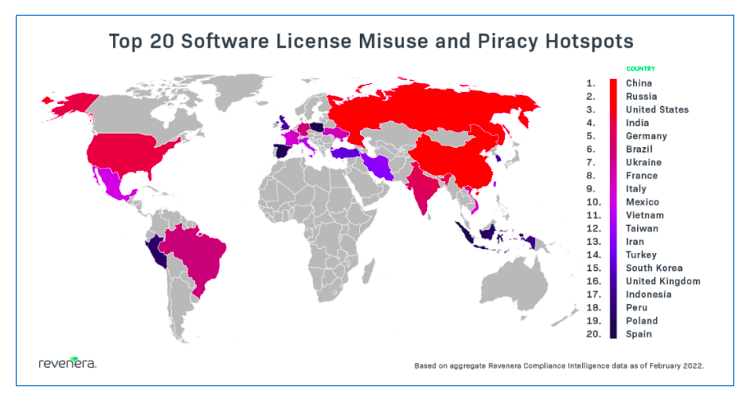
Those who use your software found it, love it, and want to use it. Unfortunately, some people use your software without paying for it. Software piracy – the use of software that’s been configured or tampered with to remove or bypass license enforcement – happens. So does overuse (use of software exceeding the limits of the license) and misuse (intentional configuration of the software to enable use beyond the limits of the license, such as through cloning or credential sharing). The result: Software suppliers miss out on revenue.
Clearly, it’s important that you are paid. But customers also benefit by paying for your software. By doing so, customers get access to the product’s functionality, modules, and updates to which they are entitled. They are at reduced risk of exposure to malware, of exposing an organization to other security threats, and to the legal risks of unlicensed use. When they purchase the right type and amount of software, they can achieve cost efficiencies and receive updates and the full support that come with properly licensed software.
With the right data and insights, the adoption of pirated software can teach you about gaps in your licensing and pricing. It can be a channel for leads and new license revenue if you can convert those unlicensed users into happy customers who get long-term value from your product. To do so, consider the environment that allows for piracy, how to measure the scope of the issue, and how to tap into the license revenue opportunity that it presents.
Know the Scope of Exploited Software
Software piracy is a global reality. In 2022, the top software license piracy and misuse hotspots are China, Russia, the United States, India, and Germany. By evaluating countries with strong intellectual property (IP) laws, track records of successful license compliance initiatives, and the commercial value of unlicensed software, software piracy represents a nearly $20 billion opportunity in new license revenue for software suppliers.

Software piracy, overuse, and misuse happen for various reasons. They can happen by current customers or by users who should be considered as prospects. Complicated or poorly implemented licensing models may lead some users to bend (or completely ignore) the rules – the terms of your end-user license agreement (EULA). These issues also take place when business models aren’t aligned well with monetization models (perpetual, subscription, usage-based, outcome- or value-based) – a particular concern as companies transition their software deployments from on-premises and embedded to software-as-a-service (SaaS) and cloud-based models. Additionally, revenue leakage happens when existing customers receive updates that they’re not entitled to receive.
Many software suppliers, however, aren’t very aware of the scope of what’s happening. Approximately four out of 10 do not know how much revenue is lost to software piracy, overuse, and/or misuse. Gaining this insight is a prerequisite for stopping the revenue loss. Doing so requires collecting product usage data, understanding how end customers are using your product, and having clarity into product adoption data.
Don’t Sit on Your Data
Software license compliance is possible – contrary to what a lot of software suppliers might think. A robust compliance program protects your IP, strengthens your revenue, and can improve customer relationships. Since there is a legitimate need to protect your IP as well as your customers’ interest it, detection and reporting on unlicensed software can be consistent with your privacy policy.
Key to an effective compliance program: the ability to get actionable data and the initiative to use that data to strengthen your licensing and use rights. If those who are infringing are already customers, this provides the ability to bring them along as fully engaged, paying customers. If they aren’t yet customers, taking action allows you to onboard them as customers who have the right access to the right products that best meet their needs.
Jesse K. Martin, associate general counsel and senior director, compliance solutions, at BSA Compliance Solutions, recently highlighted factors that indicate a need for compliance. Your organization may be ready for a compliance program if customers are confused because of a lack of functionality within the software, which may be a cracked or trial version with limited or outdated features; if users who don’t have appropriate licensing are engaging with your company, often through support tickets; if you have direct knowledge of infringements; or if feedback from your resellers highlights an area that needs to be addressed.
Identify What’s Best for Your Organization
There’s no single best approach to compliance. Strategies may vary depending on the countries in which the software piracy is taking place and on your own organization’s approach to and parameters for remediation. Enforcing licensing and capturing revenue involves multiple considerations, including:
- Getting legal and sales teams aligned;
- The IP laws and enforcement approaches in each country where piracy is taking place;
- Your organization’s preferred initiatives (e.g., letter campaigns, civil lawsuits, and/or criminal enforcement approaches); and
- Your company’s approach toward both existing customers and prospects.
All of this must be considered as part of a layered approach to software license compliance, as I’ve addressed previously. A data-driven approach facilitates compliance by tying actionable data from usage analytics to software license compliance efforts, identifying and prioritizing problem areas. Software usage analytics helps pinpoint processes that can identify and measure revenue loss. Ultimately, the goal is to gain the data insights that can make it easier for companies to use – and pay for – your software.
